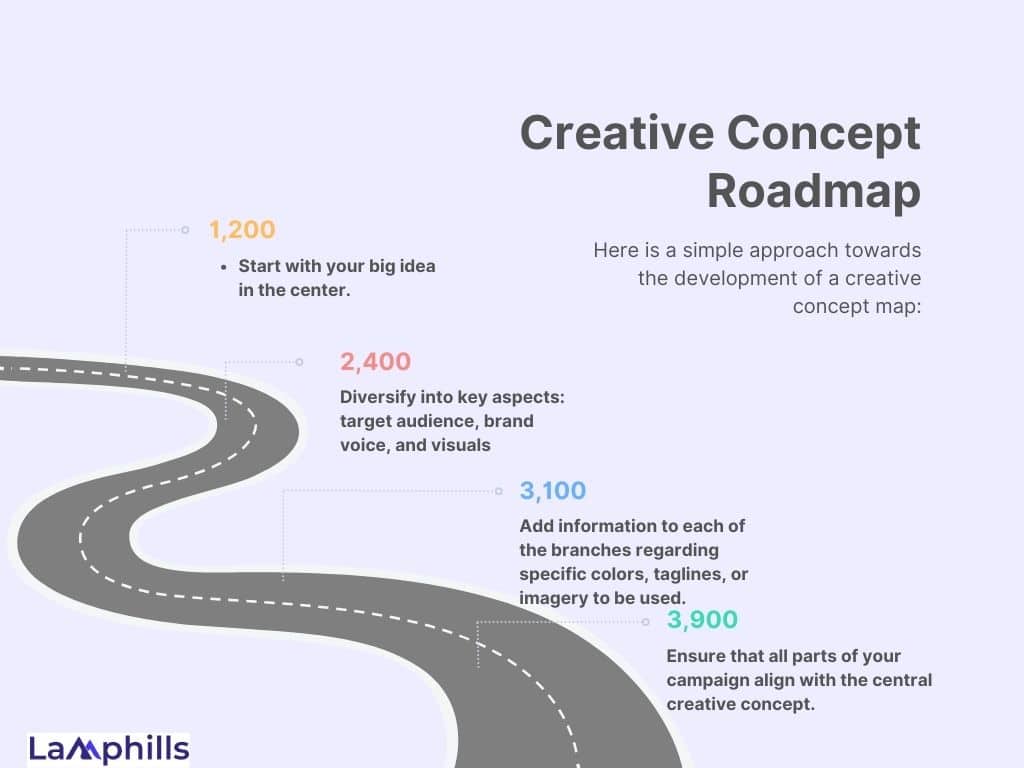With marketing, have you ever wondered what makes it just so memorable? Is it that catchphrase that hits right, the striking images, or simply one of those vibes? Well, it’s actually the creative idea that holds it all together. In this article, I will show you how to develop a winning creative concept for your marketing campaign that will leave a lasting impression.
Key Points
- A powerful creative concept serves as the central theme of a marketing campaign, guiding its messaging, visuals, and tone. It helps brands stand out in a crowded market by resonating with the audience and driving engagement.
- To develop an effective creative concept, marketers must deeply understand their target audience’s demographics, psychographics, needs, and motivations. This ensures that the concept aligns with their values and interests.
- Establish clear campaign objectives using the SMART framework and select key performance indicators (KPIs) to measure success. This allows for adjustments in strategy and validates the campaign’s effectiveness.
- The process of creating a winning concept includes brainstorming ideas, testing them with a small audience for feedback, and creating a concept map to visualize and ensure consistency across all campaign elements.
Creative Concept
It would be like embarking on a road trip without Google Maps if you launched a campaign without a plan.
You must, however, implement a plan. A strategy provides a path to follow, but without originality, it becomes cliched.
In order to advance your company with both purpose and flair, a creative strategy combines creativity with a well-organized plan.
How, therefore, can you develop your own creative strategy?
The creative concept is the overriding theme that guides the visual, messaging, and tone for a campaign. It is literally the “big idea” that resonates with an audience and drives a desired action. This gives your campaign its personality and makes it stand out from the competition.
Think of it this way: if your campaign were a movie, the creative concept would be that movie’s plot. It influences the tone of the soundtrack as well as the messaging in the script and the cinematography. Without an interesting creative idea, your campaign risks becoming forgotten, as is the case with most advertisements.
Why is Creative Concept Marketing Important?
Let’s be quite frank here: ads bombard people these days. A strong creative concept helps your brand cut through the noise and really pop. It creates a cohesive narrative to which your target audience can attach and with which they can more firmly engage. Think about one of the most iconic ad campaigns ever: Nike’s famous “Just Do It.” It is a simple yet powerful creative concept—empowerment through action.
How to Develop a Creative Concept: Step by Step
Here’s where things get interesting. Developing a winning creative concept isn’t rocket science, but it focuses on gaining a concrete understanding of an audience, goals, and brand identity. Here’s how I typically go about it:
# 1. Know Your Audience Inside and Out
You can’t have a solid concept without knowing who you are talking to. Your audience’s needs, wants, fears, and motivations should be the foundation for your creative concept.
- Demographics: How Old Are They? What Sex Are They? Where Do They Live? How Much Do They Make?
- Psychographics: What are their values, hobbies, and interests?
For example, if your target comprises eco-oriented millennials, then you can base your idea on sustainability and community-driven action.
#2. Set Clear Objectives
What do you need to achieve with your campaign? Whether it be increasing brand awareness, driving sales, or promoting a new product, this must be in line with your creative concept. If your product is a luxury item, for example, your concept might focus on exclusivity and assurance.
Additionally, use the SMART framework. Set specific, measurable, achievable, relevant, and time-bound goals.
#3. Brainstorm Ideas
Now this is where the fun part begins—brainstorming.
Round up your team members and begin reeling them off. This stage is dedicated solely to brainstorming crazy ideas; think outside the box.
Pro tip: Try using mind mapping or the "Yes, and..." method to build on each other's ideas. The more perspectives you bring, the more creative your concept will be.#4. Select KPIs

Success must be measurable. Although it may seem obvious, just 31% of marketing teams track return on investment. Success measurement is crucial because it enables you to modify your tactics quickly and justify your efforts.
Select key performance indicators (KPIs) that will inform you if you need to change course or if you are on course. For instance, if you’re introducing a new product, think about monitoring customer feedback scores or sales conversion rates.
Tip: Verify that the KPIs you have selected support your overarching business goals. A KPI like "reach" or "impressions" may be more pertinent than one like "sales conversions" if your objective is to raise brand awareness. Always connect your measurements to the overall picture.#5. Set a timeline
Decide the dates and methods for each stage of your plan. A timeline keeps you and your team on schedule and in alignment by showing a clear overview of the project’s objectives, significant events, and deadlines.
#6. Test Your Concepts
Before you go full steam ahead, it is very important to test your creative concept with a small audience. Gather feedback and see if that concept rings any bells. Assuming you swapped roles with your clients, ask questions like:
- Does this concept interest you?
- Is there an emotional connection?
- Would you be bound to take action?
This stage helps you refine your concept before launching your campaign to the audience.
#7. Create a Concept Map
A concept map is a visual representation of your ideas. Start with your key message at the center and branch out with distinct elements, like tone, visuals, and key messages. This will help you see how everything connects and ensures consistency across all channels.
Creative Concept Marketing
Have you ever tried asking yourself why a particular marketing campaign appeals to you at first sight while another one does not? The answer lies in the application of concept marketing, especially in the creative industry. It is the simple yet unifying concept that defines a campaign, guides its content, aesthetics, and attitude. Creativity is the fundamental driving force of any successful marketing campaign and must therefore have a powerful creative idea at its core. This is the story that attracts your audience, holds their attention and makes them act in the way you want.
What is creative concept marketing as a form of promotion, particularly in the case of new products?
In layperson’s terms, creative concept marketing is the major brand message that drives a marketing campaign. It is the strategic idea that informs your content, the visuals, and the character of the campaign. Best described as the cornerstone of the entire marketing effort.
For example, Apple’s iconic “Think Different” campaign used a simple yet profoundly creative concept. This idea turned into the basis of their advertisement, thus making the message attractive and emotional.
What is the Importance of Creative Concept?
Having a wonderful concept to support creativity to capture the audience’s attention is critical. I think the ads are irritating in today’s society, and one cannot escape them regardless of where they turn to. Lacking a message that stands out and that the public can easily identify with, your campaign is likely to go unnoticed.
An effective idea is not only eye-catching but also unifies the content when shared across social media. From a social media campaign to a TV ad to a billboard ad, the creative concept is the beacon of light, guiding the creators to align their content to the main theme.
To develop an impactful creative concept, you need to focus on a few key elements:
- Simplicity: This means the intended message should be easily understandable. It is important that your audience cannot lose track of what you are getting at.
- Clarity: The message should be clear and easy to understand. Your audience shouldn’t have to guess what you’re trying to convey.
- Emotional Appeal: A powerful concept connects with the audience on an emotional level. Whether it’s humor, inspiration, or empathy, tapping into emotions makes your campaign more memorable.
Creative Concept Map

A creative concept map is an excellent tool for organizing your thoughts. It’s essentially a visual representation of your concept, showing how unique elements like messaging, visuals, and emotions tie together.
Here is a simple approach towards the development of a creative concept map:
- Start with your big idea in the center.
- Diversify into key aspects: target audience, brand voice, and visuals
- Add information to each of the branches regarding specific colors, taglines, or imagery to be used.
The concept’s map goal is to ensure that all parts of your campaign align with the central creative concept.Maximizing Creative Concept Map for Effective Creative Marketing in 2024: A Detailed Template
Examples of Creative Concepts
Let me give you a few examples of creative concepts to get the juice flowing.
#1. Apple’s “Think Different”
Apple’s creative concept in the late 1990s was all about challenging the status quo and thinking differently. This concept resonated deeply with innovators, entrepreneurs, and creatives who saw Apple as more than just a tech company—it was a brand that represented freedom and individuality.
#2. Coca-Cola’s “Share a Coke”
The creativity behind Coca-Cola’s “Share a Coke” campaign was quite simple: personalization. By replacing its iconic logo with popular names, Coca-Cola urged people to share a Coke with someone special. This drove not only sales, but also created a personal relationship between the brand and its customers.
How to Keep Your Creative Concept Consistent
Of course, the real challenge, once you have that winning creative concept, is making sure it’s steadfastly consistent across all channels. Here’s how I do it:
Create a Brand Style Guide
Your brand guide needs to outline everything from the tone of voice right to color schemes and messaging. It’s a sort of blueprint that ensures your concept stays just that—concept—whether it’s running a TV ad, a social media campaign, or a billboard.
Engage with Teams
Consistency is a team sport.
Make sure there is clarity on the creative concept and how to execute it at every touchpoint, from marketing through to sales. A regular cadence of check-ins and collaborative tools supports consistency.
Monitor and Adjust
A winning creative concept doesn’t happen overnight. Once your campaign is live, be sure to monitor its performance.
Are people engaging with it the way you had hoped?
If not, be prepared to make tweaks in hopes of improving its effectiveness.
Why Creative Concepts Fail—And How to Avoid It
Not every creative concept is going to be a home run, and that’s okay. Here’s why some fail and how to avoid common pitfalls:
It’s too complicated.
It should be a very simple, easy-to-understand creative concept. If your audience has to work too hard for a clear view of your message, they may lose interest.
It’s not your Brand.
Your idea needs to be very organic to your brand. If you are a serious, professional brand, then a humorous concept will just not click well with your audience.
You don’t test it.
Always test your concept with a sample audience before going big. This gives you valuable feedback and the chance to make adjustments.
What Is the Creative Concept?
The creative concept is the overriding theme that guides the visual, messaging, and tone for a campaign. It is literally the “big idea” that resonates with an audience and drives a desired action.
What Is the Creative Concept in PR?
A broad “big concept” that draws attention and conveys a message uniquely is a creative concept in public relations. All offers, campaign platforms, marketing disciplines, and a broad range of audiences can leverage it as a unifying theme.
What Is the Difference Between a Creative Idea and a Creative Concept?
A creative idea is a single thought or inspiration. It’s often a unique or unexpected way to solve a problem or communicate a message. For example, using superheroes in an ad to sell a product.
See: 12+ Creative Content Ideas for Social Media to Keep Your Followers Engaged
A creative concept, however, is the bigger picture. It’s the framework that ties together all your creative ideas into a unified message for a campaign. It guides everything, from visuals to tone. So while the creative idea might be superheroes, the concept could be about “ordinary people achieving greatness.”
In short, the idea is a piece; the concept is the whole puzzle!
Conclusion
There you have it—a rundown of how to develop a winning creative concept for your marketing campaign.
What’s the key takeaway?
Keep it simple, stay true to your brand, and always put your audience first. The process of developing a creative concept is much more than just a brainstorming session on cool ideas. It involves creating something that deeply resonates with your audience and motivates them to take action. Follow this guide carefully, and I am sure you will come up with a concept that stands out in the jungles of marketing in 2024. Thanks for reading, and don’t forget to wish yourself luck when you are engaged in your campaign!
Related Posts
- Real-Time Marketing Campaigns: Best Practices and Examples for Instant Success
- 20+ BEST SOCIAL MEDIA ADVERTISING EXAMPLES FOR 2024
- How to Create the Best Influencer Marketing Campaigns: A Comprehensive Strategy Guide





